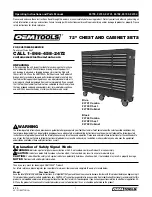
Load balancing
The creation of separate cluster groups for each virtual server provides more flexibility in balancing
the processing load on the cluster between the two nodes. Each cluster group can be assigned to a
cluster node with the preferred owner parameter. For example, if there are two cluster groups, the
cluster could be set up to have the first cluster group owned by Node A and the second cluster group
owned by Node B. This allows the network load to be handled by both devices simultaneously. If
only one cluster group exists, it can only be owned by one node and the other node would not serve
any network traffic.
File share resource planning issues
CIFS and NFS are cluster-aware protocols that support the Active/Active cluster model, allowing
resources to be distributed and processed on both nodes at the same time. For example, some NFS
file share resources can be assigned to a group owned by a virtual server for Node A and additional
NFS file share resources can be assigned to a group owned by a virtual server for Node B.
Configuring the file shares as cluster resources provides for high availability of file shares. Because
the resources are placed into groups, ownership of the files can easily move from one node to the
other, as circumstances require. If the cluster node owning the group of file shares should be shut
down or fail, the other node in the cluster will begin sharing the directories until the original owner
node is brought back on line. At that time, ownership of the group and its resources can be brought
back to the original owner node.
Resource planning
1.
Create a cluster group for each node in the cluster with an IP address resource and a network
name resource.
Cluster resource groups are used to balance the processing load on the servers. Distribute
ownership of the groups between the virtual servers.
2.
For NFS environments, configure the NFS server.
NFS specific procedures include entering audit and file lock information as well as setting up
client groups and user name mappings. These procedures are not unique to a clustered deployment
and are detailed in the Microsoft Services for NFS section within the “Other network file and
print services” chapter. Changes to NFS setup information are automatically replicated to all
nodes in a cluster.
3.
Create the file share resources.
4.
Assign ownership of the file share resources to the resource groups.
a.
Divide ownership of the file share resource between the resource groups, which are in turn
distributed between the virtual servers, for effective load balancing.
b.
Verify that the physical disk resource for this file share is also included in this group.
c.
Verify that the resources are dependent on the virtual servers and physical disk resources
from which the file share was created.
Permissions and access rights on share resources
File Share and NFS Share permissions must be managed using the Cluster Administrator tool versus
the individual shares on the file system themselves via Windows Explorer. Administering them through
the Cluster Administrator tool allows the permissions to migrate from one node to other. In addition,
permissions established using Explorer are lost after the share is failed or taken offline.
HP ProLiant SB460c SAN Gateway Storage Server
103
Содержание ProLiant SB460c
Страница 56: ...File server management 56 ...
Страница 74: ...Microsoft Services for Network File System MSNFS 74 ...
Страница 114: ...Troubleshooting servicing and maintenance 114 ...
Страница 116: ...System recovery 116 ...
Страница 120: ...BSMI notice Japanese notice Korean notice A B Class A equipment Class B equipment Regulatory compliance and safety 120 ...
















































